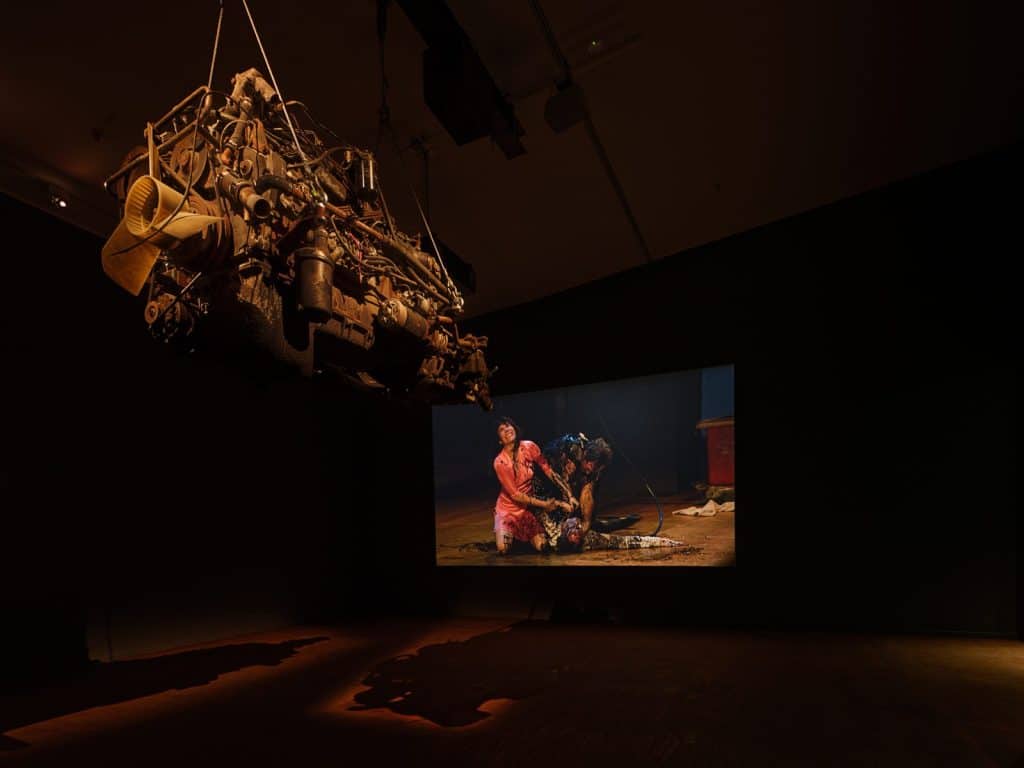Theater en film hebben nauwe banden. Veel klassieke theaterstukken zijn verfilmd. Een van de verdiensten van Ivo van Hove en Jan Versweyveld is dat ze die relatie hebben omgekeerd. Film als vertrekpunt voor hun voorstellingen. Hun radicaal vernieuwende werk is het uitgangspunt voor de – door hen zelf – vormgegeven tentoonstellingen over theater over film over theater.
In 13 zalen lopen we door het oeuvre van van Hove en Versweyveld. Ze tonen de voorstellingen die gebaseerd zijn op films. Of liever: op de scenario’s van films en hun herinnering. Van Hove weigert om de films nogmaals te zien, liever gaat hij op zijn geheugen af, en op zijn stevige filmkennis. Als goed kind van de jaren ’70 heeft hij een encyclopedie van Europese auteursfilm in zijn brein, waaruit hij scenario’s filtert die iets toevoegen aan alle bestaande theaterteksten. Rocco e i suoi fratelli van Visconti is daar een van. In deze film wordt armoede en klassenongelijkheid in één klap duidelijk als een autodeur een onoverkomelijke hindernis blijkt. Auto’s waarin op het Italiaanse platteland van de jaren ’50 dus alleen voor de elite, de armen wisten letterlijk niet hoe zo’n ding werkt.
Vertaalslag
Hoe breng je zo’n sterk beeld naar het theater? Door niet een letterlijke vertaling te willen maken, maar door de emotionele essentie te vangen. Jan Versweyveld heeft de rijke wereld van Visconti gestript tot een aantal speelvlakken die dienst kunnen doen als boksring of als eettafel. Er staat niets te veel op het toneel, waardoor alles essentieel is. Of, zoals elders te horen is: theater is acteurs, tekst en toeschouwers. Niets meer. (naar After the Rehearsel van Ingmar Bergman) De essentie van armoede en migratie blijft en heeft niets aan relevantie ingeboet.

Voor de theateradaptaties is het probleem dat er in film geen eenheid van tijd en ruimte is. Dat is een vertaalslag die Jan Versweyveld maakt. Ook hij grijpt daarbij niet terug op de film, maar gaat uit van zijn eigen kijkervaring. De twee kunstenaars hebben vanaf hun studententijd veel tijd doorgebracht in filmhuizen. Toch kijken ze niet met het doel er wellicht een bewerking van te maken. Veel van de films waarmee ze werken hebben ze in de jaren ’70 en ’80 gezien en pas decennia later geadapteerd. Hun beider vak bepaalt wél hoe ze zich films herinneren, zijn het de personages en de teksten of de ruimte en filmische aspecten.
Van Hove bepaalt de parameters, wij mogen invullen
De wandeling door de zalen is een ervaring die zowel theatraal, filmisch als museaal is. Je kunt je eigen tempo bepalen (er is voor meer dan anderhalve dag aan beeldmateriaal te zien), maar niet je eigen route. De parameters zijn bepaald, daarbinnen is er vrijheid, net zoals van Hove werkt met zijn acteurs. Door je positie in de kamers hoor je het geluid van een of meerdere schermen. Je kunt je op de aangewezen plaats gaan zitten of staan en naar 1 scherm kijken. Je kunt ook door de kamer laveren en graantjes meepikken van alle filmfragmenten en de voorstellingsregistraties.
Alle kamers hebben hun eigen sfeer. Versweyveld heeft voor iedere ruimte een eigen wandbedekking gemaakt, gebaseerd op de voorstellingen. Ook zijn er rekwisieten, maquettes en kostuums te zien. In sommige ruimtes valt er zelfs wat te ruiken. Maar echt uniek is de belichting. Versweyveld is een meester in het gebruik van licht en alle kamers zijn met uiterste precisie belicht in een vorm die past bij de voorstelling en de film. Hij zet de toon en je voelt het effect bijna fysiek. In sommige ruimtes lijkt het warmer dan in andere.
Dramatische opbouw
De wandeling door de ruimtes heeft een begin, midden en eind waarin het naar een dramatische crux gaat. De proloog is India Song van Marguerite Duras. Oude Betamaxtapes zijn gruizig geworden, de kleur geel domineert maar de acteurs zijn vage gedaantes. Het past op een vreemde manier dan toch bij de voorstelling, waarin de acteurs vooraf opgenomen teksten playbackten. Het begin is kalm en vervreemdend. De toon is gezet.
We gaan van Antonioni naar Pasolini. De heftigheid neemt toe, het volume van de acteurs ook. Het emotionele hoogtepunt is – hoe kan het ook anders – van Ingmar Bergman. Zijn Cries and Whispers, over hoe om te gaan met de dood, is aangrijpend. Van Hove heeft er twee eindes voor gemaakt: de gedroomde dood, kalm en tussen geliefden en de gevreesde dood: eenzaam en bang. Een kunstenaar die haar eigen doodsangst tot kunst verwerkt, met Yves Klein blauwe verf haar doodstrijd vastlegt. En zo legt het de kern van het theater bloot: theater als een droom, over verloren paradijzen en gewenste utopieën. Wat fijn om door de droom te kunnen lopen.
All about theater about film is te zien van 3 oktober t/m 9 januari bij Eye Filmmuseum. Alle films waarop de voortellingen van Ivo van Hove en Jan Versweyveld zijn gebaseerd, zullen worden vertoond, samen met een selectie van films die essentieel waren voor hun oeuvre.
